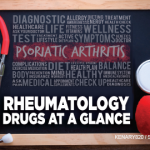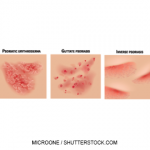 Anaphylaxis is a common adverse drug effect reported to the U.S. Food & Drug Administration (FDA) via MedWatch, the FDA’s Adverse Event Reporting System (FAERS), and 14 drugs commonly prescribed by rheumatologists are on the list of the top 50 drugs that can cause anaphylaxis.1
Anaphylaxis is a common adverse drug effect reported to the U.S. Food & Drug Administration (FDA) via MedWatch, the FDA’s Adverse Event Reporting System (FAERS), and 14 drugs commonly prescribed by rheumatologists are on the list of the top 50 drugs that can cause anaphylaxis.1
Health professionals, patients and consumers all voluntarily report adverse events to the FDA. Individuals may also report adverse drug events to manufacturers. By regulation, when a manufacturer receives a report from a healthcare professional or consumer, it is required to send that report to the FDA.2
The database of reported reactions supports the FDA’s post-marketing safety surveillance program for drug and therapeutic biologic products. It’s used to identify new safety signals for marketed pharmaceuticals. If a potential safety concern is identified in the database, the FDA may take regulatory action, such as updating a product’s label, restricting a product’s use, communicating new safety information to health professionals and the public, or removing a product from the U.S. market. Although a drug can have a temporal association with a reaction when prescribed, causality is often difficult to determine. Consequently, firm conclusions about the prevalence, incidence and causality of adverse reactions cannot be determined from these voluntary reports.
Anaphylaxis is a well-known, severe adverse reaction for some drug classes, but newer drugs with novel mechanisms of action may contribute to anaphylaxis in unpredictable ways. Yu et al. evaluated the top drugs and drug classes associated with anaphylaxis and anaphylaxis followed by death reported through FAERS. Using the search terms anaphylactic shock or anaphylactic reaction and sorting cases by generic drug names, the researchers counted and trended FAERS reports from 1999 through 2019 in which a drug was associated with anaphylaxis or anaphylaxis followed by death.1 The top 50 drugs and drug classes associated with anaphylaxis were identified.
During the time frame reviewed, 17,506,002 adverse drug events were reported, of which 47,496 (0.27%) events reported an anaphylactic reaction or anaphylactic shock. Of these 47,496 anaphylactic events, 2,984 (6.3%) anaphylactic incidents proved fatal. The median age was 52, and 63% of the patients were women. Reports from the U.S. made up 13,899 of 34,381 (40.43%) of all FAERS anaphylactic reports that listed a country. The other reporting countries included Canada, Germany, France, the U.K. and Japan.
The top five classes of drugs associated with anaphylaxis were:
1. Antibiotics, comprising 24.9% of reactions;
2. Monoclonal antibodies, comprising 13.1% of reactions;
3 & 4. Non-steroidal anti-inflammatory drugs (NSAIDs) and acetaminophen, comprising 8.8% of reactions; and
5. Intraoperative agents (e.g., atracurium, cefazolin, fentanyl and lidocaine), comprising 8.6% of reactions.
At 4.4%, omalizumab was the drug with the most reported incidents of anaphylaxis. The high incidence of omalizumab-associated anaphylaxis was due to its many on-label and off-label uses, such as treating immediate-hypersensitivity and IgE-mediated inflammation, including idiopathic anaphylaxis, which may confound results.
The drugs most commonly prescribed/used by rheumatologists and rheumatology professionals in all reporting countries are listed below, as ranked on the list of top 50 drugs that may cause anaphylaxis:
3—Infliximab
7—Ibuprofen
9—Acetaminophen
10—Diclofenac
11—Adalimumab
12—Rituximab
13—Methotrexate
17—Etanercept
20—Naproxen
28—Aspirin
33—Celecoxib
40—Abatacept
47—Tocilizumab
49—Hydroxychloroquine
For anaphylaxis followed by death, the overall rate was rare, making up only 0.01% of total adverse event reports (17,506,002). The median age of patients reported to have had anaphylaxis followed by death was 60 years old, and 50% were women. The top drug classes for anaphylaxis followed by death were antibiotics (20.8%), radiocontrast agents (12.1%), intraoperative agents (11.9%), chemotherapy agents (9%) and monoclonal antibodies (5.7%). Fifty-six drugs were associated with 20 or more reports of anaphylaxis followed by death, and six drugs had more than 20% of their anaphylactic reactions lead to death. However, none of these six drugs is commonly used in rheumatology practice.
Of the top 20 drugs reported in association with general anaphylaxis, the seventh ranking drug, ibuprofen, had seven reported deaths from anaphylaxis in a total of 1,015 reported anaphylactic reactions. The study authors note that although many NSAIDs caused anaphylaxis, very few reactions were followed by death.
Monoclonal Antibodies
The researchers performed a linear regression for each major drug class associated with anaphylaxis. The linear regression for monoclonal antibodies showed an increasing slope over time, with the percentage of anaphylaxis reactions each year increasing faster than any other drug class evaluated, at an average rate of 0.77% of total FDA anaphylaxis reports, from 2% in 1999 to 17.4% in 2019. This may be due to the increased number and use of newer monoclonal antibodies for different indications in patient care.
Monoclonal antibody agents were five of the top 10 anaphylaxis-causing drugs reported in the U.S., accounting for 13,899 reports. The two monoclonal antibodies used in rheumatology were infliximab, accounting for 3.26% of reported anaphylactic events, and adalimumab, accounting for 2.4% of reported anaphylactic events. Naproxen and ibuprofen also made the top 10 list of anaphylaxis-causing drugs in the U.S., accounting for 1.73% and 1.7% of reported events, respectively.
Monoclonal antibody agents and disease-modifying anti-rheumatic drugs (DMARDs) accounted for five of the top 10 anaphylaxis-causing drugs reported to the FDA by Canada. The total number of anaphylaxis reports from Canada was 3,268, with 22.3% for methotrexate, 13.1% for adalimumab, 17.8% for etanercept, 15.4% for leflunomide, 14.8% for abatacept, 13.6% for rituximab, 13.1% for hydroxychloroquine, 12.9% for infliximab and 9.2% for tocilizumab.
Other factors: Generally, intravenous drugs used to treat infections, cancer, rheumatic conditions and immunologic disease were disproportionately represented, compared with other agents reported as leading to anaphylaxis, the researchers write. Rituximab and infliximab, which were among the top anaphylaxis-causing monoclonal antibodies in the study, are reported to contain alpha-gal allergen. Galactose-alpha-1,3-galactose (alpha-gal) is a carbohydrate found in mammalian cells and alone can lead to anaphylaxis.3 These monoclonal antibodies were also associated with a higher proportion of anaphylaxis followed by death.1
The researchers also note that infliximab and rituximab contain polysorbate 80, an inactive ingredient that has been implicated as an allergen causing anaphylaxis and non-IgE-mediated mast cell activation in some patients. It’s unknown whether the reaction is due to the drug or the carrier(s).
Limitations
One important limitation of this study is that FAERS is a voluntary database of adverse events. Thus, not all information or every reaction is reported.
Additionally, monoclonal antibodies are administered under stricter supervision than other treatments because of their high cost and usually their non-oral administration routes as specialty pharmaceuticals. This closer drug administration, witnessed directly by clinicians, may explain the higher rate of adverse event reporting of anaphylactic reactions for these treatments.
Another major limitation of the self-reported, voluntary FAERS data is its lack of denominator data and high risk of selection and reporting bias. These data should not be used to estimate the true incidence of general anaphylaxis or anaphylaxis followed by death for these drugs. Ethnicity data, which helps determine genetic contributors, is also lacking. However, the FAERS data can be used to identify themes and trends in anaphylaxis and guide the medical community in determining what types of testing strategies are most relevant for patient care.
Overall, this study of the FAERS database identified antibiotics as being highly reported for anaphylaxis and anaphylaxis followed by death. The study also identified an emerging trend in reports of anaphylaxis due to monoclonal antibody therapies. It’s important to make note of the agents that lead to anaphylaxis so that we, as clinicians, can remain vigilant and monitor our patients for potential reactions.
Michele B. Kaufman, PharmD, BCGP, is a freelance medical writer based in New York City and a pharmacist at New York Presbyterian Lower Manhattan Hospital.
References
- Yu RJ, Krantz MS, Phillips EJ, et al. Emerging causes of drug-induced anaphylaxis: A review of anaphylaxis-associated reports in the FDA Adverse Event Reporting System (FAERS). J Allergy Clin Immunol Pract. 2021 Feb;9(2):819–829.e2. Epub 2020 Sep 28.
- U.S. Food & Drug Administration. Questions and answers on FDA’s Adverse Event Reporting System (FAERS). 2018 Jun 4.
- Watson K. Alpha-gal allergy. Healthline Media. 2019 Jan 30.



